Norway is the undisputed king of fjords, with more than 1,100 of the things dotted along its massive coastline. And if you’re planning a trip, there’s good news: it’s actually quite tricky to visit Norway without seeing at least one of these beautiful geological features for yourself.
You’ll find fjords pretty much wherever you go – from Lindesnes in the very south to Cape Nordkinn in the far North – but a handful of them are extra special, and certainly worth seeking out if you have the time to spare.
To save you lots of legwork and get you straight to the prime photo spots, we’ve rounded up 12 of Norway’s best and most dramatic fjords. This map shows you where they are in relation to big cities like Oslo.
Geirangerfjord
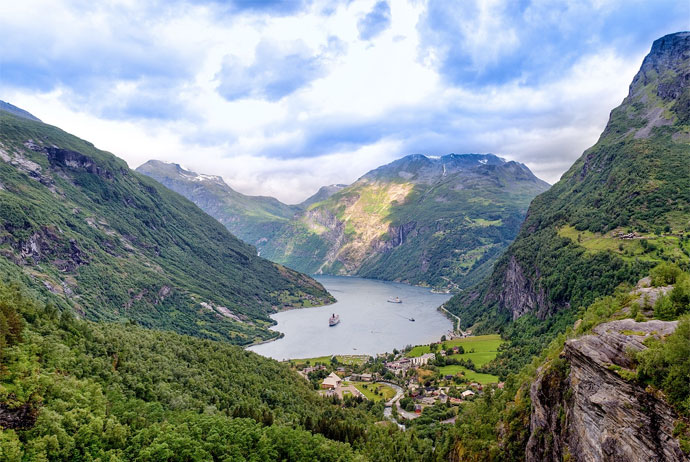
Geirangerfjord is, without doubt, Norway’s most famous fjord. Appearing in the Norwegian movie The Wave and Disney’s Frozen has certainly helped, and Geirangerfjord is among the country’s most visited tourist attractions.
Along with Nærøyfjord, some 120km away, it forms part of a Unesco World Heritage Site. Make no mistake, this is classic fjord scenery!
The fjord is located in the district of Møre og Romsdal, two and a half hours from Ålesund. Wherever you stop near the fjord, you’ll be treated to stunning views of steep mountaintops rising quickly out of the water.
There are several impressive waterfalls here too, including the jaw-dropping Seven Sisters (which, unbelievably, doesn’t even make the top 40 in the list of the highest Norwegian waterfalls).
All of this stunning scenery is actually under threat. A huge chunk of a nearby mountain called Åknesfjället is slowly breaking free, and is expected to plunge into the fjord in the not-too-distant future, causing a huge tsunami that is likely to wipe out the small village of Geiranger.
In 1934, a similar landslide at Tafjorden (around 20km to the northeast), caused a series of vast waves that killed 40 people.
The mountain at Geirangerfjord is monitored closely, though, and experts expect to be able to give plenty of warning so that locals can evacuate. Our advice is to go soon, before the fjord changes forever!
Getting there
Geirangerfjord is best visited in the summertime. You can get there by cruise from Ålesund, or by road, approaching via a nerve-wracking series of hairpin turns called Trollstigen. If you’d rather not drive the Trollstigen yourself – and who can blame you – you can experience it on a guided tour from Ålesund.
Where to stay
The Grande Fjord Hotel is just over a mile from the village of Geiranger and has smart, clean rooms, some with balconies overlooking the fjord. Alternatively, Geirangerfjorden Feriesenter offers compact self-catering units with exceptional views.
Hjørundfjord
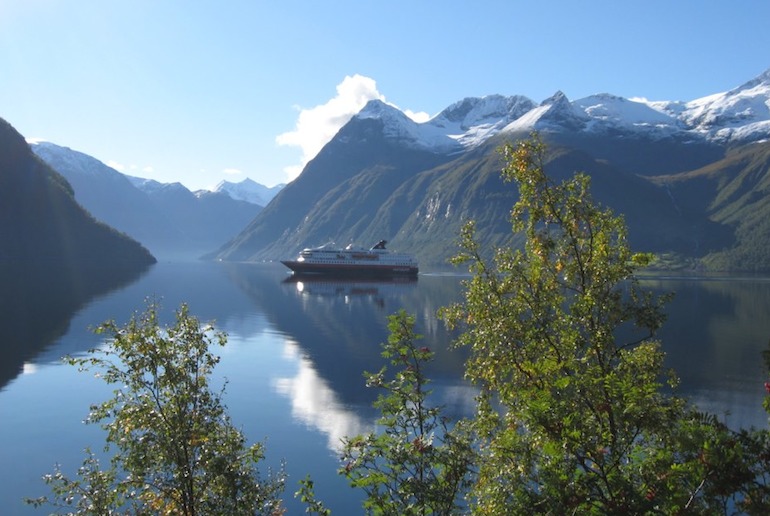
Deep and narrow, the 35km long Hjørundfjord is one of the less-visited fjords, its blue-black waters overlooked by glowering mountains that plunge straight into the fjord.
A branch of the Storfjord, it lies south of Ålesund and is surrounded by the stunning forested Sunnmøre Alps, some of whose peaks reach some 1,500 metres above the water.
There are few settlements along the shores of the fjord, as the steep mountainsides make building difficult, and people tend to come here for its brooding tranquillity and beautiful walks in the surrounding mountains.
The hike from the pretty village of Øye up Mount Slogen is challenging but rewards you with great views over the fjord.
Getting there
From Ålesund, it takes around two-and-a-half hours to drive to Sæbø, on the western shores of the fjord, via the Solavågen-Festøya car ferry across the Storfjord. Alternatively, Hurtigruten boats call in to the Hjørundfjord.
Where to stay
The comfortable and smart Sagafjord Hotel in Sæbø sits right on the waterfront, or splash out on the historic – and supposedly haunted – Hotel Union in the remote village of Øye.
Sognefjord
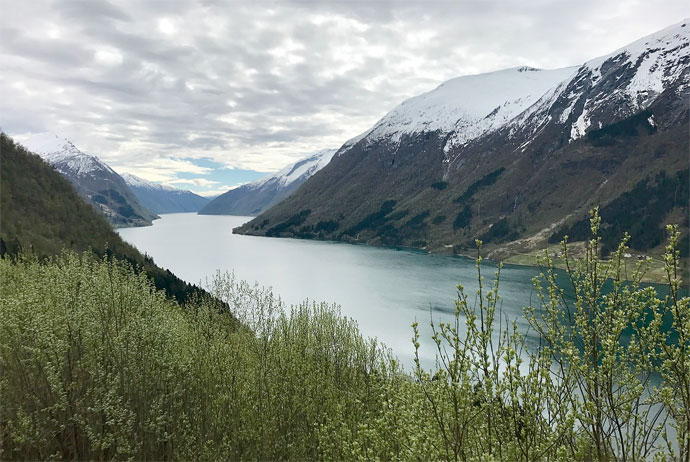
Sognefjord is the longest fjord in Norway, and also the deepest. Located in the district of Sogn og Fjordane in western Norway, it stretches out in shades of brilliant blue and emerald green for more than 200km, and is more than 1.3km deep in parts.
This is more of a region than an attraction that you’d just go and look at, so it requires a bit more effort to really get to grips with. You can spend time driving between idyllic mountain villages, hiking (try the Jotunheimen National Park at the fjord’s eastern end), or checking out the beautiful wooden stave church in Kaupanger.
Jostedalsbreen – mainland Europe’s largest glacier – is worth a stop if you want to try hiking on the ice.
There’s lots to see in the Sognefjord region and journeys can be surprisingly slow. Fortunately there are plenty of places where you can enjoy a cosy overnight stop, usually with the bonus of great views to wake up to.
Getting there
From Bergen, the Sognefjord region is best reached by car (it takes around four hours to get to Sogndal).
Where to stay
Lavik Fjord Hotell is pricey but some of the modern rooms offer great views. There are also some excellent hiking trails nearby. Botnen Camping has cheaper bunk rooms and simple cottages.
Nærøyfjord
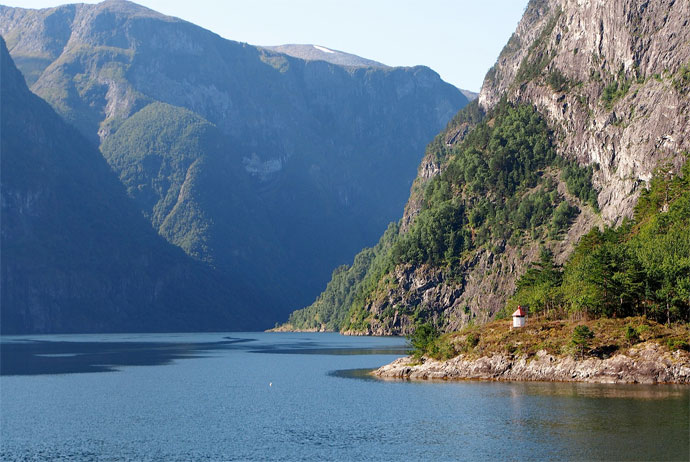
Nærøyfjord is actually a part of Sognefjord. Along with Geirangerfjord (see above) Nærøy makes up part of a World Heritage Site. It’s 17 km long but in places can be extremely narrow – just a couple of hundred metres across at its narrowest point.
The fjord is surrounded by mountains that soar more than a kilometre above the waterline, making this one of the most dramatic places to visit in all of western Norway.
Even if it rains (and it probably will) this is a spectacular place to take photos, have a picnic, or simply stare in awe.
Getting there
Nærøyfjord is a popular stop on tours that start from Oslo and Bergen. You can also get there independently by rental car from Bergen – you’d first need to cover the two-hour drive to Gudvangen and then board the ferry to Flåm, a journey which follows the length of Nærøyfjord and the neighbouring Aurlandsfjord.
Where to stay
Brekke Gard hostel in Flåm is a good cheap place to stay and is a short drive from Nærøyfjord. Lærdal Ferie- og Fritidspark, located around 50km northeast in Lærdalsøyri, has affordable self-catering apartments, while the good-value Gudvangen Budget Hotel is in the village of Gudvangen right at the southern tip of the Nærøyfjord.
Hardangerfjord
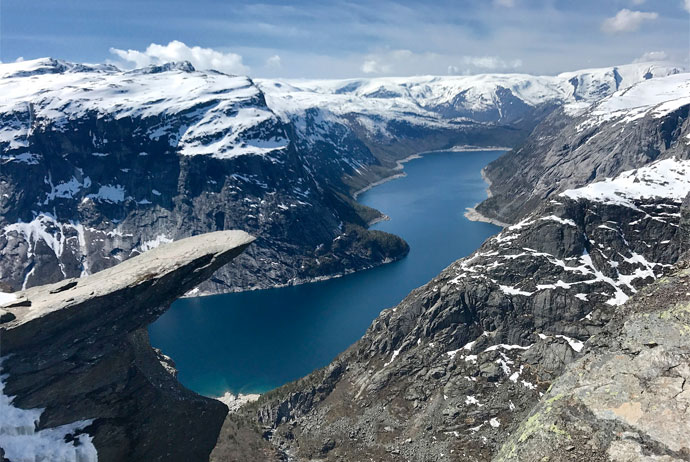
Hardangerfjord is Norway’s second longest fjord. From its mouth, which opens up to the North Sea some 80km south of Bergen, Hardangerfjord stretches inland towards the Hardangervidda National Park.
This region is home to the picturesque village of Odda, situated at the very end of the fjord, which serves as a beautiful base for sightseeing and outdoor activities.
More famously, it’s also home to the rock formation called Trolltunga (the ‘troll tongue’) which attracts tens of thousands of hikers every summer and should be on any serious fjord fan’s bucket list. There are some very good article source and the fjord.
Getting there
The drive to Odda takes around four hours from Stavanger, three hours from Bergen or two hours from Haugesund. You can also get there directly by express bus from Oslo, Bergen, and Haugesund.
Where to stay
The rooms at Odda Camping are functional and fairly cheap (by Norwegian standards, anyway), while the Trolltunga Hotel has simple but comfortable rooms in Odda, some overlooking a lake.
Nordfjord
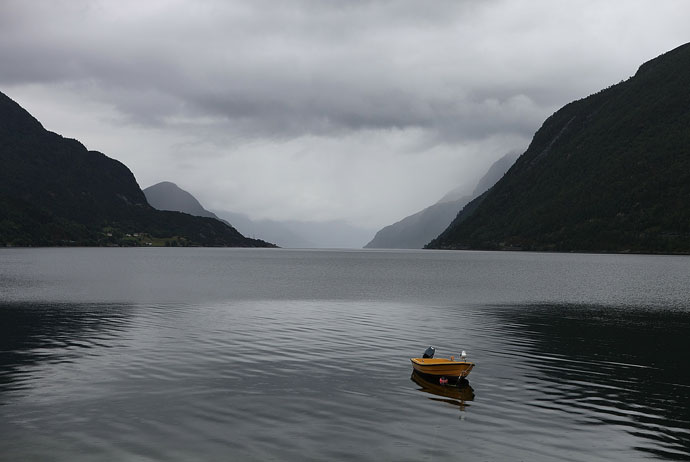
Nordfjord is another gorgeous slice of scenery in the Sogn og Fjordane region of western Norway. Apart from the great views, it’s also near the Jostedalsbreen glacier (see above) and the newly established Loen Skylift at Innvikfjord (a branch of Nordfjord), which brings you to the top of the 1km-high Mt. Hoven in just five minutes.
Getting there
The village of Nordfjordeid, at the eastern end of the fjord, is the best place to stay near the fjord. It’s a three-hour drive from Ålesund. However, you can also reach Nordfjordeid by express bus from Oslo, and by express boat from Bergen.
Where to stay
The upmarket Nordfjord Hotel in Nordfjordeid has reasonable rooms, along with a pool and a spa, or there’s the cheaper Sentrum Hotel, with basic, clean rooms.
Most popular tours:
View more at article source by Vanessa Brune

